Seasoned Tomato Sauce Recipe for Home Canning
This post may contain affiliate links, which means that I may receive a commission if you make a purchase using these links. As an Amazon Associate I earn from qualifying purchases.
No store bought tomato sauce compares with the flavor of homemade. Capture summer in a jar with this seasoned tomato sauce recipe for home canning.
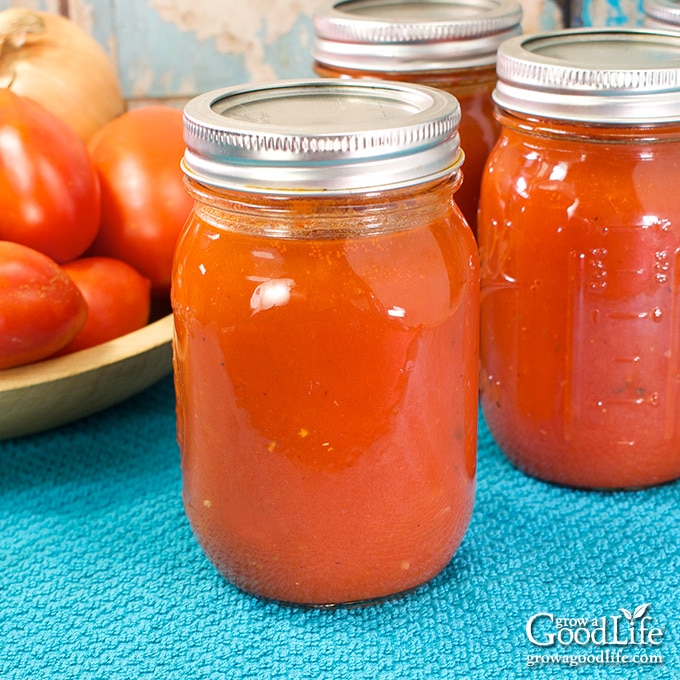
I talk about canning tomato sauce a lot here at Grow a Good Life, especially this year as I faced the challenge of preserving a bumper crop. It seems I constantly had baskets of ripe tomatoes to work through for the last two months. Now that the final tomato harvest is simmering on the stove, I thought it was time to share the tomato sauce recipe and method I use to preserve the majority of my homegrown tomato harvest.
Growing up in an Italian household, the only tomato sauce we were aware of was the homemade kind made from canned or fresh tomatoes in season. There were no jars of purchased tomato sauce in our pantry. As an adult, I continued the tradition cooking up large batches of homemade tomato sauce and freezing it for future meals.
When I began growing a garden of my own, one of the first things I learned to can was tomato sauce from homegrown tomatoes. Eventually, I made it my yearly goal to grow enough tomatoes to provide a sufficient amount of canned tomato sauce to last us until the following season.
No store bought tomato sauce compares with the flavor of homemade. This is the seasoned tomato sauce recipe and method I use to home can the tomato harvest.
Tips for Canning Tomato Sauce
Here are tips for turning freshly harvested tomatoes into homemade tomato sauce and canning it in shelf stable jars:
Follow a Safe Canning Recipe
If you are canning tomato sauce, is important to use recipes that are formulated and tested for safe home canning. When I make tomato sauce for canning, I follow the seasoned tomato sauce recipe in the Ball Blue Book Guide to Preserving. This is the closest to the homemade tomato sauce I grew up with.
Use Paste Tomatoes
Use plum type tomatoes for a flavorful and thick sauce. My favorites are Amish Paste, Juliet, Roma, and San Marzano. Plum tomatoes, also referred to as paste tomatoes, are meaty with thick walls and have very little water content. You can still use other types of tomatoes, but it may take longer for the extra water to cook out.
Choose good-quality tomatoes with no signs of rot, insect damage, or disease. Don’t use tomatoes from frost-killed vines as the acidity may have changed or these may harbor harmful pathogens that may not be killed during processing.
Remove Skins and Seeds
If you are canning tomatoes, you need to remove the seeds and peels in recipes that call for it. So far, there are no tested canning recipes that include the skins. The peels may harbor bacteria, and add unwanted texture to the sauce. Additionally, the peels and seeds may affect the density of the sauce, preventing heat from penetrating properly when processed in a water bath canner.
This recipe calls for simmering the tomato sauce with the skins and seeds first, and then straining out the solids from the tomato pulp. Cooking with the skins and seeds aids in extracting the natural pectin that will help thicken the sauce.
The way I do the initial cooking depends on the weather. If it is hot outside, I will simmer the sauce on the stove as described in the recipe. If the weather is cooler, I roast the vegetables first in a 325˚F oven until softened, about an hour. Then add all the ingredients to a pot and simmer until the sauce has thickened and reduced by half. Roasting adds a lovely, deep tomato flavor to the finished sauce. Be sure to include all the liquid that releases from the tomatoes.
After the sauce has reduced by one-half, strain with a food strainer or food mill to remove solids, and smooth out the sauce. Then return the sauce to the stove, heat to a simmer, and fill the jars.
If you don’t have a food strainer, you can blanch and peel the tomatoes, and scoop out the seeds before making your sauce: See How to Peel Tomatoes for an illustrated, step-by-step tutorial.
Acidifying Tomatoes
When canning tomatoes, an acid is needed to ensure that the pH is at a level that prevents the growth of C. Botulinum bacteria, which causes botulism. There are two simple ways you can use to adjust the acidity when canning tomatoes. Add citric acid or commercial bottled lemon juice:
- Citric acid is my favorite way to acidify tomatoes because it does not affect the flavor.
- Bottled Lemon Juice: Bottled lemon juice has been uniformly acidified so there is a consistent and known acid (pH) level that is needed for safe canning. Don’t use fresh squeezed lemon juice because there is no way to know the level of acid in the juice.
Don’t Have a Water Bath Canner?
You can use a standard large stockpot as long as it is tall enough to cover the jars by two inches of water, and at least two more inches of air space to prevent boiling water from splashing out. You will need to use a rack in the bottom of the pot to hold the jars up away from direct heat, so they won’t break, and can in smaller batches depending on how many jars your pot will hold.
Steps to Making and Canning Tomato Sauce
This home canned seasoned tomato sauce is perfect for tossing with spaghetti and pasta, spreading on homemade pizza, and spooned over chicken or eggplant Parmesan.
Before you begin, it may be helpful to review this article on water bath canning at the National Center for Home Food Preservation website.
This is a safe caning recipe from the Ball Blue Book Guide to Preserving for “Seasoned Tomato Sauce.” The differences between this recipe and the Ball seasoned tomato sauce is this recipe has been cut in half. I just find working with a smaller batch of tomatoes much easier to manage since I only have two large pots to cook down the sauce.
Seasonings have been adjusted slightly to reduce the amount of salt, and increase the sugar to balance the tart flavor of the tomato sauce. I also reduce the sauce by slow cooking it over low heat for a longer period to preserve flavor rather than cooking over medium-high heat as indicated in the Ball recipe. Sometimes this takes all day, but the flavor is worth the effort.
The full and printable recipe can be found at the bottom of this article, but these are the steps for making and canning Italian seasoned tomato sauce:
Step 1: Gather Your Equipment
You’ll need:
- Water bath canner with canning rack
- 8 pint sized canning jars, or 4 quart sized jars
- Canning lids and bands (new lids for each jar, bands can be reused)
- Canning tools: jar lifter, canning ladle, funnel, and bubble popper
- Kitchen scale
- Food strainer, food mill, or sieve
- Plus basic kitchen supplies such as a large saucepan, large prep bowls, towels, measuring cup, measuring spoons, large spoon, knife, and a cutting board.
Step 2: Prepare the Ingredients
Weigh and wash tomatoes well under clean, running water, and spread out to air dry on towels. Remove the peelings from the onions. Chop and measure 3 cups of chopped onions. Peel the garlic and mince.
Step 3: Cook the Sauce
Heat a large skillet over medium heat, add the olive oil, and sauté the onions until softened. Add the garlic and cook briefly until fragrant, then add the mixture to your saucepan.
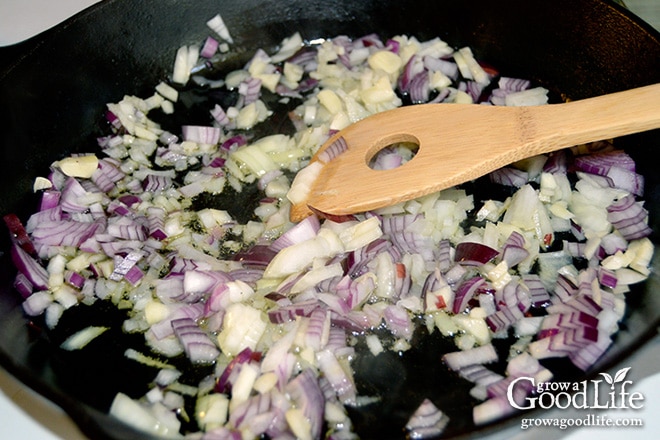
Cut the tomatoes in half or quarters and add to your pot along with the oregano, bay leaves, black pepper, sugar, and red pepper flakes if using. Hold off on the salt for now and add it to taste at the end.
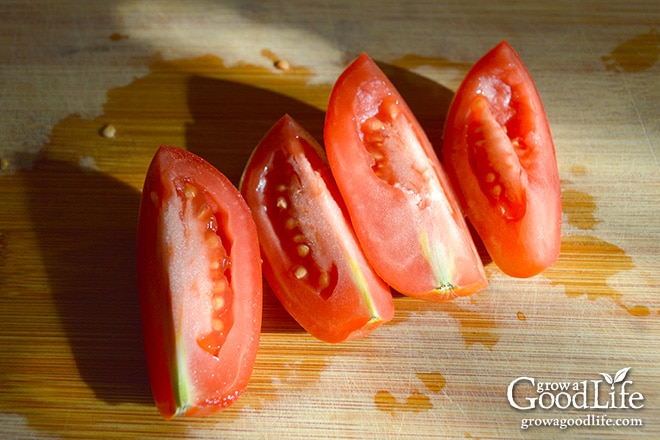
Cover and bring the pot to a simmer over low heat. Vent the cover to let the moisture evaporate, and continue simmering to thicken the sauce until reduced by one-half. The cooking time will vary depending on the amount of moisture in your tomatoes. Stir occasionally to prevent sticking.
If you are using multiple pots, roughly divide the ingredients for each pot, and combine into one pot as the sauce cooks down. Use your ladle to avoid splashing.
Once the volume is reduced by half, turn off the heat, and let it cool slightly so you won’t burn yourself when straining.
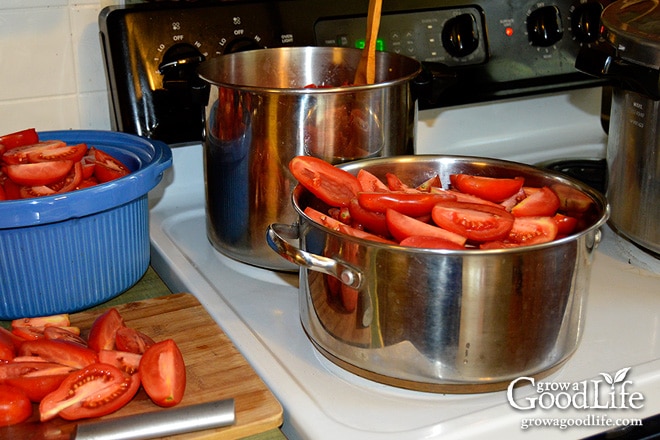
Step 4: Prepare the Canning Equipment
While the sauce is cooling, prepare the jars, set up the canner, and organize your work area.
Wash your jars, lids, bands, and canning tools in warm, soapy water. Rinse well, and set the lids, bands, and tools aside to air dry until you are ready to use them.
Jars must be heated before filling to prevent breakage due to thermal shock. Place the jar rack into the water bath canner, set the jars upright in the canner, and add water to cover the jars. Bring the canner to a simmer (180˚F) for 10 minutes, and keep the jars hot until you are ready to fill them.
Follow the manufacturer’s directions for preparing the lids. Pre-heating lids is no longer necessary before using, but it is still safe to simmer (180°F) the lids if you want to. Just add them to the canner when you heat your jars.
Step 5: Strain the Sauce
Remove the bay leaves, and run the tomato sauce through a food strainer or food mill to remove skins, seeds, and to smooth out the sauce. Return the sauce to the pot, and bring the sauce back to a simmer (180˚F). Use a clean spoon and taste the sauce. Add salt and stir in. Taste again. Add more salt if needed.
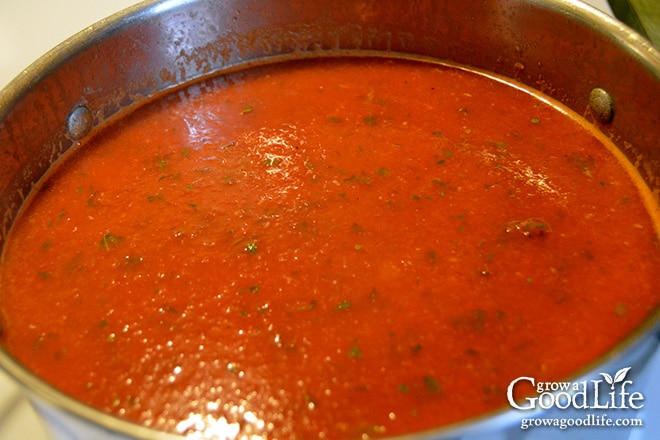
Step 6: Can the Sauce
Spread a kitchen towel on the counter, and place the citric acid or lemon juice nearby along with the measuring spoons.
Use the jar lifter to remove a hot jar from the canner, drain, and place on the towel. Keep the remaining jars in the canner, so they stay warm.
Add citric acid or lemon juice to the jar. For pints, add 1/4 teaspoon of citric acid, or 1 tablespoon of bottled lemon juice to each jar. For quarts, add 1/2 teaspoon citric acid or 2 tablespoons of bottled lemon juice to each jar.
Place the canning funnel on the jar, and ladle hot sauce into the jar while leaving 1/2-inch headspace. Run the bubble popper through the jar to release any trapped air bubbles.
Wipe the rim with a damp towel to remove residue. Center a lid on the jar, place the band over the lid, and screw it on until fingertip tight. Place the jar back into the canner, and repeat with the rest of the jars.
Adjust the water level so it is covering the jars by several inches, bring the pot to a boil, and process the jars for the times indicated in the recipe below. Let the jars cool, test the seals, label and date the jars, and store in a cool, dark location.
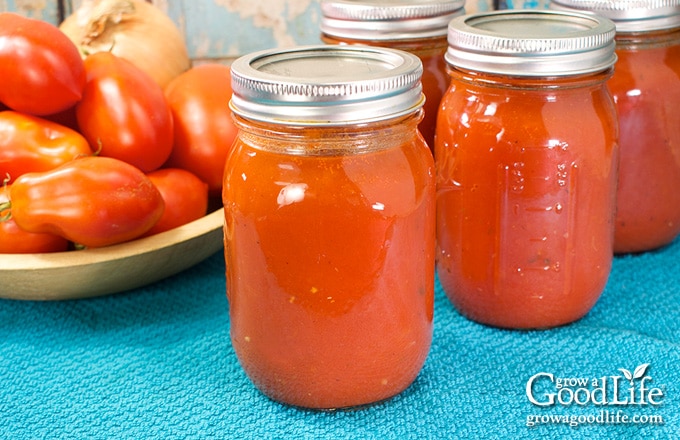
Seasoned Tomato Sauce Recipe
Ingredients
- 22.5 pounds paste tomatoes
- 3 cups chopped onions about 3 large onions
- 6 cloves garlic minced
- 1/4 cup extra virgin olive oil
- 3 dried bay leaves
- 1 tablespoon dried oregano
- 1 teaspoons cane sugar
- 1.5 teaspoon ground black pepper
- 1 teaspoons red pepper flakes optional
- citric acid or bottled lemon juice
- 1 teaspoon kosher salt or more to taste
Instructions
Prepare the Ingredients
- Weigh the tomatoes, rinse well under clean, running water, and air dry on a clean towel.
- Remove the peelings from the onions. Chop and measure 3 cups of chopped onions. Peel the garlic and mince.
Make the Sauce:
- Heat a large skillet over medium heat, add the olive oil, and sauté the onions until softened. Add the garlic and cook briefly until fragrant, then add the mixture to your saucepan.
- Cut the tomatoes in half or quarters and add to the pot along with the bay leaves, oregano, sugar, black pepper, and red pepper flakes if using.
- Bring the pot to a simmer over low heat, and continue simmering to thicken the sauce until reduced by one-half. Stir occasionally to prevent sticking.
- Once the volume is reduced by half, turn off the heat, and let the sauce cool slightly before straining.
Prepare the Canning Equipment:
- Wash your jars, lids, screw bands, and canning tools in hot soapy water. Rinse thoroughly to remove all suds. Set aside to air dry on a clean kitchen towel.
- Place the jar rack into water bath canner, place jars in the canner, and add water to cover. Bring the canner to a simmer (180˚F) for 10 minutes, and keep the jars hot until you are ready to fill them.
Can the Sauce:
- Remove the bay leaves, and purée the tomato sauce using a food strainer or food mill to remove skins, seeds, and to smooth out the sauce. Return the strained tomato sauce to the saucepot, and bring back to a simmer (180˚F).
- Use a clean spoon and taste the sauce. Add salt and stir in. Taste again. Add more salt if needed.
- Spread a kitchen towel on the counter. Place the citric acid or lemon juice along with the measuring spoons next to the towel.
- Use your jar lifter to remove a jar from the canner, drain, and place on the towel. Keep the remaining jars in the canner so they stay hot.
- Add citric acid or lemon juice to the jar. For pints, add 1/4 teaspoon of citric acid, or 1 tablespoon of bottled lemon juice to each jar. For quarts, add 1/2 teaspoon citric acid or 2 tablespoons of bottled lemon juice to each jar.
- Use your canning ladle and funnel and add the hot sauce to the warm jar leaving 1/2-inch headspace. Swirl your bubble popper through the jars to release air bubbles. Wipe the rim of each jar with a damp towel.
- Center a lid on the jar, and screw on the band until it is fingertip tight. Use the jar lifter to place the jar back into the canner, and repeat with the remaining jars. Try to leave some space in between the jars.
- Once all the jars are in canner, adjust the water level to two inches above the jar tops.
- Cover the canner and bring to boil over high heat. Once water boils vigorously, set your timer, and process pints for 35 minutes and quarts for 40 minutes at altitudes of less than 1,000 ft. Adjust processing time for your altitude if necessary (see notes).
- When processing time is complete, turn off the heat and allow the canner to cool down and settle for about 5 minutes.
- Spread a kitchen towel on the counter, and remove the cover by tilting lid away from you so that steam does not burn your face.
- Use the jar lifter to lift jars carefully from canner and place on the towel. Keep the jars upright, and don't tighten bands or check the seals yet. Let the jars sit undisturbed for 12 to 24-hours to cool.
- After the jars have cooled for at least 12 hours, check to be sure jar lids have sealed by pushing on the center of the lid. The lid should not pop up. If the lid flexes up and down, it did not seal. Refrigerate the jar and use within a few days.
- Remove the screw on bands and wash the jars. Label, date, and store your jars in a cool, dark place. Use within 12 to 18 months. Refrigerate the sauce once opened and consume within a few days. Yields about 6-7 pint jars or 3-4 quarts depending on how much the sauce reduces.
Notes
- Pints at altitudes of 1,001 - 3,000 ft. is 40 minutes, 3,001 - 6,000 ft. is 45 minutes, and above 6,000 feet is 50 minutes.
- Quarts at altitudes of 1,001 - 3,000 ft. is 45 minutes, 3,001 - 6,000 ft. is 50 minutes, and above 6,000 feet is 55 minutes.
Nutrition
This article was originally published on October 8, 2015. It has been reviewed and updated with additional information and new photos.
Additional Canning Information:
- USDA Complete Guide to Home Canning
- Canning Guides at the Ball Website
- 6 Tips to Prepare for Canning Season
You May Also Like:
Good planning is key to a successful vegetable garden
Whether you are new to growing your own food or have been growing a vegetable garden for years, you will benefit from some planning each year. You will find everything you need to organize and plan your vegetable garden in my PDF eBook, Grow a Good Life Guide to Planning Your Vegetable Garden.

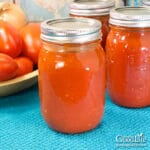

Do I need to take the bay leaves out before running through a good mill? Do I have to use the bay leaves?
April, No, you don’t have to use bay leaves. If you do use them, the food mill should strain them out, or you can remove them yourself.
This was my first time making tomatoe sauce. The instructions were very clear & detailed. The taste is very good I would be able to use this as is over pasta without adding anything else.
I made a half batch and ended up with 4 full pints and one pint that was 3/4 full
One question I put the 3/4 ful jar in the fridge but was wondering if I could have put it in the canner and boiled it that way.
I will definitely make this again
I am so glad you enjoyed the recipe. You were smart to place the partially filled jar in the refrigerator. With so much air in the jar, it may not have processed properly in the water bath canner.
Hello,
I’m being cautioned to avoid sauces that include oil, onions, and garlic by my local cooperative extension (even including extra acid/lemon juice). I made some fresh sauce following a very similar recipe to this, and it was delicious, but I’m worried it may not be safe to store for longer periods at room temp. It seems recipes like this are intended for a pressure canning method, but not water bath canning.
I know this recipe says it came from the Ball blue book, but since I don’t own the blue book, I can’t confirm this is a safe recipe to use with a water bath, which is unfortunate.
Kindly,
C.
C, You are smart to question recipes found on websites. There are many who do not follow safe canning practices or don’t use recipes that have been tested by Ball or the USDA. If you do not have Ball’s books, you can find a good collection of safe recipes on their website, freshpreserving.com. I was unable to find Ball’s Seasoned Tomato Sauce, but I did find one that is really close: Roasted Garlic Roma Tomato Sauce. You will see that this recipe also uses olive oil, onions, and garlic. Ball tests recipes in their independent food labs, so you can feel confident using this recipe to preserve your sauce.
Other safe canning recipes and canning education can be found at The National Center for Food Preservation or individual state extension websites.
Hi there. Do I understand correctly that the garlic and onions will be intentionally removed with the seeds and skin? It’s assumed their essence will remain in the sauce?
Many thanks.
Lyne, The garlic and onions soften when simmered, so they are pureed along with the tomatoes when using a food strainer or mill.
this sauce was amazing. just made a half batch and got 8 pints. Also made the crockpot one. Its cooling right now..trying the salsa 2morrow. Thx for some wonderful recipes. Marie from Canada
Can these be canned in a half pint jar & if so how long would they be processed, in a water bath, with an altitude of 3500 feet? Thank you.
Sandra, It is the same processing time for half pints and pints: 35 minutes for altitudes under 1,000 feet. Adjust to 45 minutes for altitudes between 3,001 – 6,000 ft.
I have the bumper crop you’ve experienced Coming in this season. I’ve done two dozen pints of salsa, and it’s tomato sauce time. I know sugar is fairly essential when doing a traditional Italian sauce, but I never use it when I do mine. Is it an essential in the safe canning process, or can I omit it? Thanks so much.
Jen, Sugar is for flavoring in this recipe and can be left out.
Thanks a bunch for your recipe posting and answering questions. Last week my husband forwarded me a New York Times recipe published August 22 – Make and Jar Pomodoro to Last All Year Long. The sauce recipe was interesting and we can get really good tomatoes at the farmers’ market so I was all in – except for two concerns. The first was that the other tomato sauce recipes for canning included lemon juice (or a few had red wine vinegar) to increase the acid level. The second concern was that you leave the processed jars in the hot water bath to cool overnight. (About 10 years ago, I took an online food preservation class given by Colorado State University Food Science department and I recalled that this method of slowly cooling water processed food was not safe.) Additionally, the article did not indicate that the processing time must be adjust to accommodate for elevations over 1000 feet.
I sent an email to the CSU extension office regarding my concerns hoping that they would “bless” the NYT recipe and I didn’t have to worry about botulism. Unfortunately, they did not. I did sent an email the the NYT but I don’t think anyone will ever respond. I will make this TESTED recipe.
Kathy, I am so glad you found this recipe here at Grow a Good Life. It is my favorite for preserving most of our home grown tomatoes. Unfortunately, there are a lot of recipes on the internet that are not safe for canning. I am glad you followed up on the New York Times recipe. It looks like they updated and made some corrections to the original recipe. Your comment may have saved people from getting sick.
Can I add fresh basil to this recipe ?
Lynda, Use dried herbs in canning recipes that call for them because that is how the recipe was tested. It is unknown how the extra moisture from fresh herbs affects the pH or microbial load of the canned product. You can always add fresh herbs when opening a jar.
Hi i am wondering if I can leave the skins and seeds in my sauce and still water bath them? Thanks
Paige, Always remove tomato peels and seeds in canning recipes that call for it because that was how the recipe was tested. Without testing, there is no way to know how the peels and seeds affect the pH and pathogen load, which may make the tomato sauce unsafe when canned. See: Tomato Skins at eXtension Ask an Expert. Freeze the sauce if you wish to leave the peels and seeds.
How much of the seeds need to be removed? I don’t have the device you mentioned but took out quite a bit with a seive. Will that work for canning?
Sue, Yes, using a seive will work. A few seeds won’t be a problem.